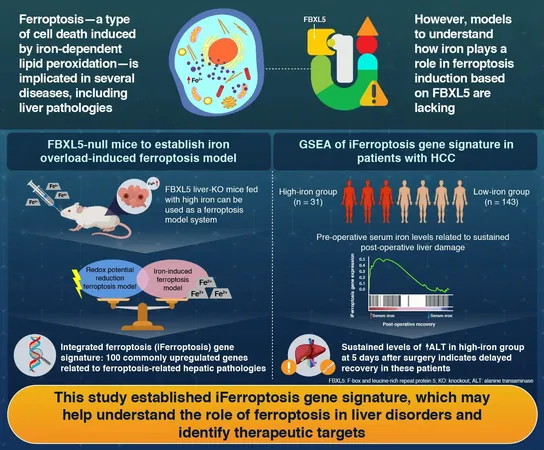
Breakthrough Discovery: Unraveling the Gene Signature of Hepatic Ferroptosis
2025-07-01
Author: Wei
Revolutionary Insights into Liver Damage and Ferroptosis
Researchers from Japan have made a groundbreaking advancement in understanding liver damage by uncovering an integrated gene signature for ferroptosis—dubbed iFerroptosis—by creating an iron overload model in mice. This innovative study not only highlights the critical role of ferroptosis in various liver injuries but also points to promising new therapeutic targets.
The Dangers of Iron Overload in the Liver
Excess iron within cells produces reactive oxygen species that wreak havoc by oxidizing phospholipids, leading to cellular destruction and a unique form of cell death known as ferroptosis. While we know ferroptosis is linked to conditions such as liver fibrosis, cirrhosis, and liver cancer, concrete models to study its effects from iron overload have been lacking.
Creating a Model for Understanding Ferroptosis
Enter Professor Toshiro Moroishi from the Institute of Science Tokyo and his collaborator Dr. Takashi Matsumoto from Kumamoto University. Together, they successfully established a mouse model that mimics iron overload-induced ferroptosis. This advancement paves the way to exploring gene expression patterns critical for potential therapies.
Unveiling Unique Hepatic Gene Expression Patterns
In their meticulous research, the team developed liver-specific FBXL5 knockout mice, which were put on a high-iron diet. The results were telling: these genetically modified mice exhibited severe liver damage and pronounced lipid peroxidation, both hallmarks of ferroptosis. This confirmed their utility as valid models for studying hepatic ferroptosis.
Identifying Key Genes in Ferroptosis
By comparing gene expression profiles between control mice and the FBXL5 liver-KO models, the researchers discovered significant differences that imply ferroptosis triggers characteristic changes in gene expression. Further analysis revealed a shared set of 100 upregulated genes across different models of ferroptosis, culminating in the establishment of the iFerroptosis gene signature.
Impact on Postoperative Recovery in Patients
Turning their focus to human health, the research team examined preoperative serum iron levels in 174 patients undergoing liver surgery. They found that those with elevated iron levels exhibited pronounced enrichment of the iFerroptosis genes and faced prolonged liver damage during recovery. This crucial insight suggests that high iron levels could be detrimental to recovery in liver surgery patients.
Future Implications for Liver Disease Treatment
In essence, this monumental study not only identified a gene signature that could predict iron-induced liver damage but also unraveled its potential as a biomarker for transplant eligibility and therapeutic interventions. Moroishi emphasizes, "Leveraging the iFerroptosis gene set will deepen our understanding of ferroptosis-related liver disorders, providing pathways for innovative treatments that could greatly enhance patient outcomes in liver diseases."



 Brasil (PT)
Brasil (PT)
 Canada (EN)
Canada (EN)
 Chile (ES)
Chile (ES)
 Česko (CS)
Česko (CS)
 대한민국 (KO)
대한민국 (KO)
 España (ES)
España (ES)
 France (FR)
France (FR)
 Hong Kong (EN)
Hong Kong (EN)
 Italia (IT)
Italia (IT)
 日本 (JA)
日本 (JA)
 Magyarország (HU)
Magyarország (HU)
 Norge (NO)
Norge (NO)
 Polska (PL)
Polska (PL)
 Schweiz (DE)
Schweiz (DE)
 Singapore (EN)
Singapore (EN)
 Sverige (SV)
Sverige (SV)
 Suomi (FI)
Suomi (FI)
 Türkiye (TR)
Türkiye (TR)
 الإمارات العربية المتحدة (AR)
الإمارات العربية المتحدة (AR)